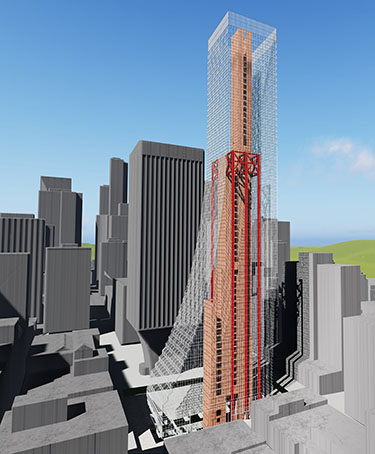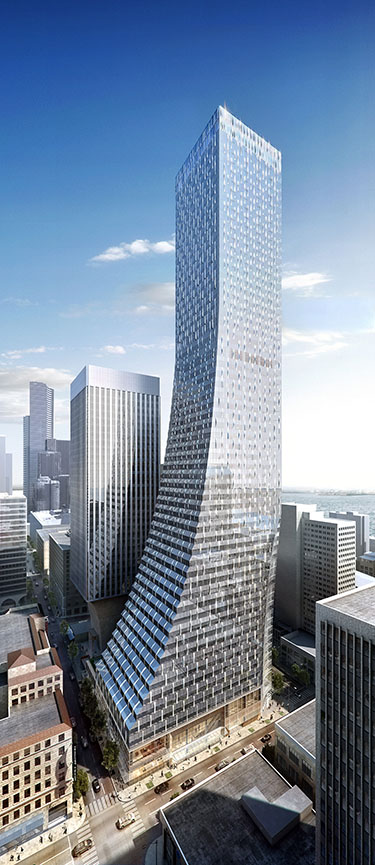|
Subscribe / Renew |
|
|
Contact Us |
|
| ► Subscribe to our Free Weekly Newsletter | |
| home | Welcome, sign in or click here to subscribe. | login |
News
| |
February 7, 2018
New structural system expected to save time, money on Rainier Square
Journal Staff Reporter
A new structural engineering system developed by Seattle's Magnusson Klemencic Associates should shave up to seven months off construction of the 58-story Rainier Square tower, the project's developer said.
Greg Johnson, president of Wright Runstad & Co., said this will result in “meaningful” savings on items such as equipment rentals, tower cranes and insurance.
His Seattle firm is developing the project at 1301 Fifth Ave. with an institutional investor advised by J.P. Morgan Asset Management.
The $570 million tower will be the centerpiece of the full-block redevelopment of the old Rainier Square complex.
Demolition is underway for what is destined to be the second tallest building in Seattle. The tower will have 722,000 square feet of office space, all leased by Amazon.com; 188 apartments; and 80,000 square feet of retail space. Seven levels of underground parking are planned.
Construction is expected to start late this year on a 12-story hotel that will share the podium. Johnson declined to say how much the hotel, a partnership between Wright Runstad and the Related Companies of New York, will cost.
The entire project is set to be done in summer of 2020.
NBBJ is designing it, Lease Crutcher Lewis is the general contractor and MKA is the structural engineer.
The redevelopment of Rainier Square, which is part of the University of Washington's Metropolitan Tract, is under an 80-year ground lease with the university.
Johnson said the accelerated schedule makes the project more competitive because it will be delivered to tenants faster, “and clearly we attracted Amazon, and that had value in that respect.”
Using the new technique with a tall structure has more impact than with a shorter one because so much of a tower's schedule is dictated by how quickly the core is erected, he said.
Wright Runstad will likely use the technique on another tall project, he said. “If it is as successful as we think, we anticipate it will start to be used more and more for tall buildings around the country,” he said.
His firm has worked with Ron Klemencic, chairman and CEO of Magnusson Klemencic Associates, on several projects. Johnson said Klemencic brought up the new technique before the Rainier Square redevelopment was envisioned, and suggested it again during conceptual design for the tower.
Klemencic said the system will be a game changer for high-rise construction, but it remains to be seen if it will pay off for low- and mid-rise construction.
The DJC talked with Klemencic about the system.
How is this different?
For the last 20 years, most of the high-rise office buildings constructed in Seattle (and around the country) have included a reinforced concrete core to brace them for wind and seismic loads. Examples in Seattle include IDX Tower (now Fourth & Madison), 1700 Seventh Ave. and Russell Investments Center, and all the newly constructed Amazon towers. This was the system of choice as it efficiently and economically provided the necessary structural stiffness and strength while also neatly and conveniently fitting into the architectural planning of the towers.
The concrete cores reinforced with rebar were cost effective, but the three to four days per floor it took to construct them was almost double the time it took to erect one floor of the structural steel floor framing surrounding the core.
That framing could not be erected until the core at each level was complete. So steel erection of the next floor was dictated by how long it took to construct the next level of the core.
The new system consists of prefabricated core modules with two steel plates that are reinforcing steel for the core. The modules are manufactured off-site, in this case by the Supreme Group in Portland, and filled with concrete on-site.
Because they are ready to go when brought on-site, they can be erected at the same rate as the structural steel floor framing, so construction can go nearly twice as fast as the last generation of buildings.
An analogy is a tortoise and hare, with the tortoise being the traditional method, and the hare what will be used on Rainier Square. Now you must give the tortoise a head start in the race to get each floor done. With the new technique, the hare is running the race by himself and the tortoise is benched.
Who developed the system?
It is an adaptation of technology originally developed in the 1990s by British Steel called Bi-Steel. It was envisioned primarily for constructing walls for blast protection. Research and development led by MKA has adapted and extended this technology for use in high-rise buildings in high seismic zones. In-house, at MKA, I championed using it for high-rise construction, starting in 2005. We didn't have a specific project in mind. We just thought it was cool and that it might have applications someday. We found a client who is ambitions enough to let us try it.
Extensive and ongoing testing at Purdue University and the University at Buffalo is providing the necessary confirmations that the system will perform as envisioned in seismic events and high winds.
Is this the first time it will be used?
This is the first use of this new system, called Concrete-filled, Composite Plate Shear Wall (CF-CPSW) core, in the United States in a high-rise building, and the first in the world in a high seismic zone.
MKA is working on a high-rise with residential, office and hotel in San Francisco, and a mid-rise office tower in Boston on which implementation of the system is being studied.
Are you using it partly because of Rainier Square's unusual shape?
No. It is being implemented primarily due to its construction schedule advantage over more traditional reinforced concrete cores. The CF-CPSW core can be used in buildings of all shapes and heights.
At what height the system becomes economical is a question we continue to study.
It is not being used on the hotel component of the Rainier Square development as the hotel is all concrete construction, with no steel involved.
What else can you tell us about the system?
Research and development of it was funded by the Charles Pankow Foundation and the American Institute of Steel Construction.
Research and testing began at Purdue University in 2005 with professors Mike Kreger and Mark Bowman, and system refinements remain ongoing at Purdue with professor Amit Varma and at the University at Buffalo with professor Michel Bruneau.
The design of the system for Rainier Square was reviewed by outside peer reviewers, including Jim Malley of Degenkolb Engineers, Ron Hamburger of SGH and Michel Bruneau, in addition to the Seattle Department of Construction & Inspections.
Lynn Porter can be
reached by email or by phone
at (206) 622-8272.




